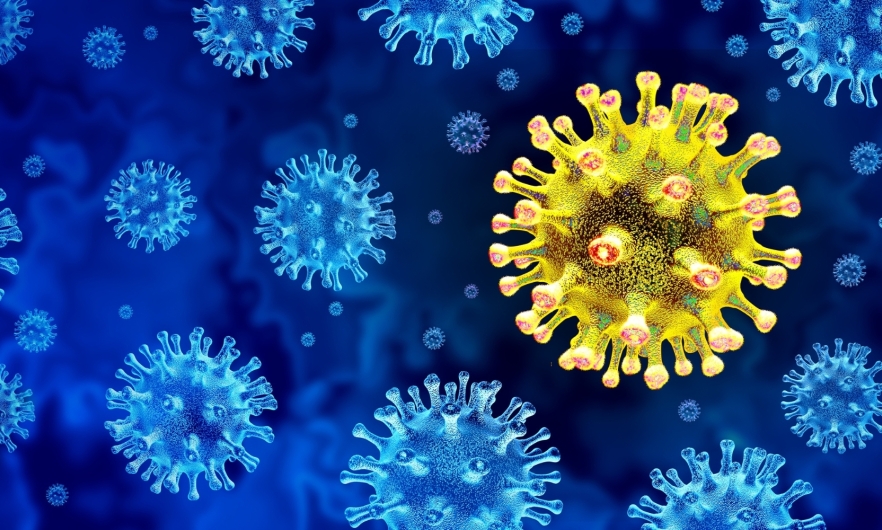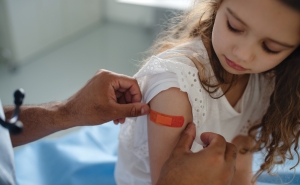What to Know About JN.1, the Latest Omicron Variant
Vaccines, tests, and antivirals are still effective tools in the latest COVID surge.

In early November 2023, the JN.1 variant caused less than 5% of COVID-19 cases in the U.S. Now it is estimated to cause more than 60% of them. Virologists including Andy Pekosz, PhD, a professor in Molecular Microbiology and Immunology, are paying attention.
Here, Pekosz explains what virologists are seeing, what this new variant means for case rates and treatments, and why it’s so important for more people to get the updated COVID-19 vaccine rolled out this fall.
What is JN.1?
A SARS-CoV-2 variant called BA.2.86 emerged a few months ago and caught virologists’ attention because it contains many more mutations—about 30 of them—to evade immunity than any other variant circulating at that time. However, the BA.2.86 variant never came to dominate among the group of SARS-CoV-2 variants that were circulating in the late summer/early fall of 2023. The JN.1 variant is a descendant of BA.2.86 that has acquired the ability to transmit efficiently through an additional one or two mutations. It has the immune evasion of its parent but has now mutated to transmit more efficiently.
What’s happening now with this variant?
The increase in the number of cases caused by JN.1 corresponds to an overall increase in COVID-19 cases. Symptoms of JN.1 infection are very similar to those of previous omicron variants, and it doesn’t seem to cause more severe disease, either. There is some suggestion that JN.1 may be causing more diarrhea than previous variants, but we don’t have any firm data supporting that yet.
What’s most important to understand about this variant?
This latest variant should be a reminder that we have tools to fight off COVID infection and minimize severe disease: Tests detect JN.1, the new vaccines protect against severe disease, and antivirals are still capable of treating infection from JN.1. We just have to use these tools more effectively than we have over the last six months.
So far, only 8% of children and 19% of adults have received the latest vaccine, so a lot of people are missing out on protection from this virus.
What does the transmission timeline look like for JN.1?
The period of infectiousness for JN.1 is very similar to that of the other omicron variants that have been circulating over the past year: You are contagious one to two days before your symptoms begin, and you are still contagious for at least two to three days after your symptoms begin—though some people can continue to have the detectable live virus for up to a week after symptom onset. After exposure, it may take five days or more before you begin to develop symptoms.
Are people who had an older vaccine or who’ve had COVID from another variant likely to be reinfected by JN.1?
The older vaccines were based on SARS-CoV-2 variants that are very different from variants circulating now. That, combined with the fact that your immunity from vaccination or infection tends to drop off over time, means that you won’t get a lot of protection from COVID-19 if you are relying on the vaccines you received nearly a year ago. It's very similar to why we have annual influenza vaccines: The virus is changing, so we have to change the vaccine to make sure it is a good match with the virus variants that are causing infection right now.
Do we know yet how well this fall’s COVID-19 vaccines work against this variant?
While the JN.1 variant does have a number of mutations that help it avoid immunity, laboratory studies suggest that the updated COVID-19 vaccine does increase the amount of antibodies that can recognize JN.1, and it is still effective in protecting against severe disease. You really need the newest COVID-19 vaccine formulation to be protected from severe illness from JN.1 and other recent variants.
COVID numbers have been rising for a few weeks now. Is it too late to get the vaccine?
No. Getting vaccinated now can provide protection during this surge. Don’t wait. This is particularly important for those in high-risk groups, but it goes for all eligible individuals.
Is Paxlovid effective against JN.1?
Paxlovid is still working very well, particularly in high-risk populations, but it’s not being prescribed as frequently as it should be. It’s important to remember that Paxlovid needs to be taken as soon as possible after symptoms begin, within five days of symptom onset is the guidance, but the earlier, the better. This means it is particularly important to test when you start feeling sick and then get a prescription if you test positive.
What might we expect in terms of case rates over the next few weeks?
Case rates will likely go up. We’re coming out of a period when we already expected transmission to go up, due to increased travel and holiday gatherings. For the rest of January and into February, we will continue to have a high amount of respiratory virus activity that includes COVID-19 cases. Now is the time to get vaccinated if you haven’t already, get some COVID-19 tests available for free from the U.S. government, and make sure your local pharmacy can fill a COVID-19 antiviral prescription if you do end up testing positive.
Aliza Rosen is a digital content strategist at the Johns Hopkins Bloomberg School of Public Health.
Melissa Hartman is the managing editor of Hopkins Bloomberg Public Health magazine and associate director of editorial at the Bloomberg School.





